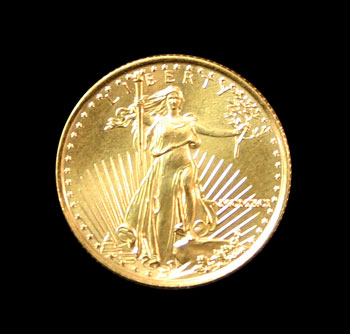Continuing our adventures with gold, let’s look at the last year of the Roman numerals on the American Eagle Gold Bullion coins. These coins include the one-tenth ounce, one-fourth ounce, one-half ounce and one ounce gold American Eagles.
Begun in 1986, the US Mint used Roman numerals for the dates through 1991. In 1992, they reverted to our decimal system of numbers using 0 through 9 for the year on the coins.
Do you know your Roman numerals? Do you know how to read Roman numeral dates?
First, let’s look at the basic list of Roman numerals:
|
Roman Numeral |
Decimal Equivalent |
|
I |
1 |
|
V |
5 |
|
X |
10 |
|
L |
50 |
|
C |
100 |
|
D |
500 |
|
M |
1000 |
As you can see, the numerals do not directly correspond to our numbers of 0 through 9. Plus, the Roman numeral system did not even include a zero.
Now, a few basic rules describe how to write and read Roman numerals:
- In general, Roman numerals are additive except when a subtraction is used to minimize the quantity of numerals to be written
- The largest numeral begins in the left-most position
- No more than three instances of a Roman numeral can be adjacent to one another
- By placing a smaller numeral in front of a larger numeral the subtraction rule applies (For example, 40 cannot be XXXX since no more than three instances of the same numeral can be adjacent. Instead, XL = 40. The ten numeral, X, in front of the fifty numeral, L, means you must subtract the 10 from the 50 to equal 40.)
- Except for the subtraction principle, the numerals should decrease in size from left to right
- Only one subtraction numeral can be used immediately in front of another
- Subtraction numerals can only be an I, X or C
For very large numbers, the Romans used a bar across the top to denote that portion of the numeral should be multiplied by 1000. Since we are learning Roman numerals for dates on coins, the maximum year-to-date requires only two Ms for 2000. Therefore, we will forego the larger examples.
Let’s look at the Roman numerals needed to write dates.
| Roman Numeral Conversion Chart | |||||||
| Thousands | Hundreds | Tens | Units | ||||
| M | 1000 | C | 100 | X | 10 | I | 1 |
| MM | 2000 | CC | 200 | XX | 20 | II | 2 |
| CCC | 300 | XXX | 30 | III | 3 | ||
| CD | 400 | XL | 40 | IV | 4 | ||
| D | 500 | L | 50 | V | 5 | ||
| DC | 600 | LX | 60 | VI | 6 | ||
| DCC | 700 | LXX | 70 | VII | 7 | ||
| DCCC | 800 | LXXX | 80 | VIII | 8 | ||
| CM | 900 | XC | 90 | IX | 9 | ||
Here’s the Roman numeral from a quarter ounce American Eagle gold coin:
With the rays on the coin, the numerals are difficult to read. More legibly, the Roman numeral states: MCMXCI.
Use the cheat sheet above and remember when a smaller Roman numeral precedes a larger one, subtraction occurs. In this example, M = 1000, CM = 900, XC = 90 and I = 1. Use addition to determine the date: 1000 + 900 + 90 + 1 = 1991.
That wasn’t so tough.
Let’s go the other direction. What would be the Roman numeral for the earliest year of the American Eagle gold coins?
Nineteen eighty-six is how we usually think of the year, but it’s easier to remember the conversion if you read the year as one thousand nine hundred eighty-six.
One thousand = M
Nine hundred = CM
Eighty = LXXX
Six = VI
String the numerals together with the largest at the left to yield: MCMLXXXVI.
That wasn’t so bad either.
In celebration of learning our Roman numerals, here are the full obverse and reverse views of an uncirculated (instead of a shiny proof) quarter ounce gold American Eagle:
Though the obverse looks similar, the Ultra High Relief from our post on October 1 is not part of the American Eagle Gold Bullion coin program. Interestingly, the US Mint chose to use Roman numerals on the Ultra High Relief: MMIX for 2009. Click here to take a look at the proof Ultra High Relief in the earlier post.
Whether on the one ounce Ultra High Relief or the quarter ounce American Eagle Gold Bullion, Lady Liberty stands tall. And, whether striding beside a Roman numeral date or a decimal number, she looks proud and beautiful.


